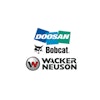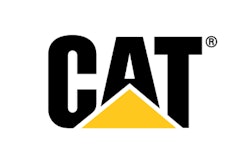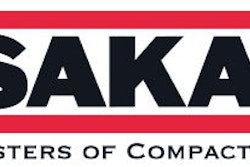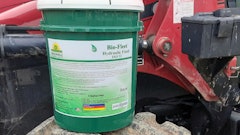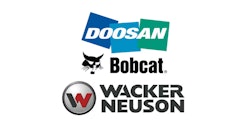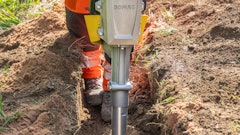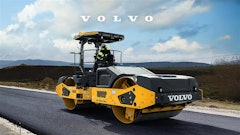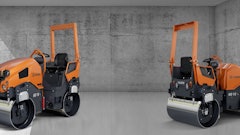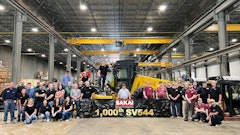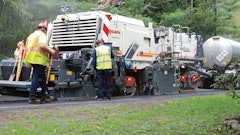
A good paving job will have a smooth, dense appearance that looks flat and tight, without any gaps between the aggregates at the surface. We all know that appearance doesn't just happen, there are a lot of factors that affect mat quality.
The paver operator, the asphalt mixture, even the distance from the asphalt plant to the jobsite all play a role in achieving optimum mat density. But the last people to touch the pavement are the roller operators, and they have the greatest influence on smoothness, and those all important density numbers.
"Roller operators need to understand their important role in the paving process, as compaction is the last step in laying down a quality pavement," Eric Booth, product training and marketing manager at Sakai says. "They need to be observant in order to monitor their machine … watching asphalt temperature, water tank level, DEF tank level, status of the DPF, and if any asphalt is being picked up by the drums, etc. The plant, milling machine and paver can do everything correct, but if the roller isn’t on the mat at the right time or not maintained correctly, they could get density issues that lead to early failures and potentially impact any guarantees the contractor may have made."
Train for Success
For asphalt contractors to be successful in today’s competitive paving market, paver and roller operators must acquire a deep knowledge of the equipment’s features and put this knowledge into practice at the job site. With long-time equipment operators retiring at a high rate, the next generation of operators must receive extensive in-depth training on the equipment in order to meet project specifications without costly rework, so companies can maximize equipment return on investment.
"Untrained personnel can cause not only bad/inadequate/undesirable results in the compacted surface, but could also be a danger at the jobsite potentially causing damage to the equipment or worse, cause harm to other personnel," Bert Erdmann, product manager compaction & assisted systems at BOMAG Americas, says. "Untrained roller operators potentially could cause undesirable results or permanently damage the material."
Over- and under-compaction of the asphalt are common mistakes operators can make and can adversely impact the final product.
"Under compaction would most likely result in inadequate densities, which could potentially result in fines or rework, depending on what the job specification requires," Erdmann says. "Over-compaction often results in breaking the aggregate which would ultimately lead to premature failure, e.g. when water can enter the asphalt layer and freezing conditions would cause the mat to fail which could for example lead to potholes etc."
Under-compaction means the pavement is more permeable to water infiltration from above or below the pavement. Long-term exposure to water will strip the asphalt cement bonding the aggregates together and the result is that the pavement will ravel or fall apart.
Over-compacting results in a pavement that has no internal, inter-connected air voids or air space, so when ambient temperatures increase or decrease, there is little or no room for expansion or contraction of the asphalt cement (binder) in the mix. The result in hot weather is that the asphalt cement flushes or bleeds to the surface and can actually result in instability of the mix or even be more prone to rutting. Operators need to know how to properly compact the mat to avoid both.
"Roller operators are often “on their own” on the job to work with the quality control personnel who are measuring density using a nuclear or non-nuclear gauge, so it is important that operators are properly trained to understand the effects of changing amplitude and frequency on a steel drum roller and how these changes affect the ability to reach density, maintain smoothness and a roller speed to keep up with the paver," Todd Mansell, product application specialist with Caterpillar, Inc. says. "Roller operator training is a three-pronged relationship between amplitude, frequency and impacts per foot, or roller speed, on a steel drum roller. Operators should always try to maintain a minimum of 10 impacts per foot to achieve density efficiently, but equally important, to meet or exceed smoothness specifications for IRI.
Mansell says the simple calculation is to take roller frequency setting and divide by 10.
"For example, the roller set on high frequency at 3,800 vpm divided by 10 = 380 feet per minute should be the maximum ground speed of the roller. 380 / 88 = 4.3 mph. Most rollers on the market today have a gauge indicating the impacts per foot, so the roller does the calculation for the operator automatically, based on the frequency setting."
The operator should be trained to understand this relationship between impacts per foot and roller speed as it is critical to maintaining smoothness on a job.
Train for Optimized Machine Use
To best achieve this, operators should be trained and given the knowledge to overcome some of the hurdles that can crop up on a project, such as difficult weather conditions, clumpy mixes, extremely thick or thin lifts, joining of hot and cold lanes, etc.
It will also help ensure the machines are being used to their fullest potential. Most roller manufacturers, in conjunction with their dealers, offer training for end users of their equipment. That training is available in a variety of forms, including group seminars, hands-on courses or one-on-one training on the jobsite or at the manufacturer's training grounds.
"Operators not only need to understand these relationships between amplitude, frequency and impacts per foot mentioned above, they must understand how to change these settings on the roller they are operating," Mansell says. "This sounds simple, but all manufacturers have different methods and combinations of how to change amplitude and frequency. Some changes are made by switches at the operator’s station, while other changes are made on the drum itself and further, a combination of the two. Understanding how to make these changes is not always intuitive if you have not been properly trained. It can be very challenging for operators, especially when they are on different rollers from day to day and job to job. All manufacturers offer charts and “cheat sheets” on how to change these roller settings. Ask for these guides and stick them on the roller somewhere obvious for the operator to review and laminate them to make them weatherproof."
Don't forget to teach safety best practices to your operators.
"Operators should know the functionality and proper use of the controls on the roller, proper rolling techniques and best practices/commonly applied rolling patterns and proper use of water (just enough to keep material from sticking, but not too much so that the asphalt mat does not cool down too fast)," Erdmann adds.
Train on Technology to Simplify Operations
Manufacturers of equipment have been hard at work trying to simplify and standardize many operations, including compaction. The main technologies that are available to help operators achieve optimal compaction are pass count mapping and temperature mapping, often collectively referred to as “Intelligent Compaction.”
"Intelligent Compaction often includes some type of stiffness-measuring instrument, most commonly an accelerometer mounted near the drum of the roller to give an indication of material stiffness by measuring the rebound of the steel drum during the compaction process," Mansell says. "The most valuable and useful tools for operators today are pass count mapping that keeps track of the number and location of roller passes and displays it to the operator in real-time during the rolling operation and the temperature mapping that helps operators stay in the proper temperature range, or zone, for optimal compaction."
BOMAG ECONOMIZER provides a stiffness gauge to the operator with direct “traffic-light-type” feedback of the current status of compaction. More sophisticated systems such as ASPHALT MANAGER take it up a notch by reducing the drum output automatically to prevent over-compaction.
"BOMAG’s BOMAP Connect is the next evolution in Intelligent Compaction," Erdmann says BOMAP Connect is a subscription-based cloud solution, connecting the BOMAP app with the ability to plan, track and document multiple compaction projects. BOMAP equipped rollers can effectively “see” each other and the projects and data exchanged with the ability to connect multiple rollers with each other on the jobsite to provide a visual compaction map. The operator and machine, the supervisor on the jobsite and even your project manager back at the office have instant connection to your job’s compaction status."
Having visibility like this helps ensure operators have real-time information on their compaction efforts so they can make adjustments accordingly to avoid mistakes.
"Roller operators are the last ones on the mat, so they normally are first to be blamed if something goes wrong," Tim Kowalski, HAMM application support manager at Wirtgen America says. "Technology today is much more sophisticated and designed to assist operators with consistency of operations while also ensuring they are doing the job correctly."
Intelligent compaction technology has been instrumental in helping contractors understand and better manage their density. Manufacturers have worked to make the data visible and easily accessible while the machine is in use.
"Intelligent compaction on HAMM rollers features color-coded pass mapping," Kowalski says. "Operators can tell the number of passes they have completed and where they have already been on the mat so they know what areas have already achieved compaction. They can also tell where to stop and start on the mat which is especially helpful during night work."
Other technologies are also available to help operators achieve their smoothness goals.
"There are a number of technologies to aid the roller operator in getting density, some being more hi-tech than others," Booth says. "Sakai offers an Exact Compact Meter to show the operator which speed gives them the appropriate impacts per foot. Rollers that utilize oscillation can hit density and smoothness in no vibration areas. Though density is goal #1, the compaction crew can’t forget about smoothness or roller efficiencies either. More states are setting smoothness requirements as part of the specifications, and getting density and smoothness in as few passes as possible is important."
Both the technology and best practices for the construction of asphalt pavements are constantly changing. Be sure to stay on top of training your operators to ensure your efforts will be successful.
"Training should be a never ending process," Kowalski concludes. "As manufacturers, we want to make sure companies are getting the most out of the equipment. We want to train operators, foreman, superintendents and even the owners on these machines and what they are designed to help with."


